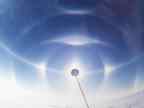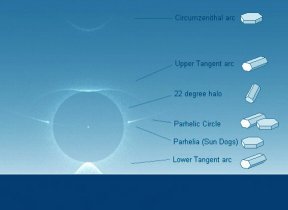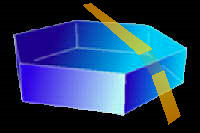Ice
Crystal Halos
... Atmospheric displays arising from snow crystals ... |
|
When sunlight reflects
and refracts off of tiny ice crystals in the atmosphere, the result can be ice crystal
halos, which are related to rainbows (the latter being produced when sunlight reflects and
refracts from water droplets). |
  The
classic introduction to the physics of atmospheric light displays is Robert Greenler's Rainbows,
Halos, and Glories. [1] A more recent book focusing on halos is Atmospheric
Halos, by Walter Tape [2]. The latter book describes ice crystal halos in
roughly the same fashion as Greenler, but with emphasis on the exquisite halos that can be
observed from the South Pole. In addition to working with the best halo displays on
the planet, Tape's photography is technically superb, resulting in spectacular images. The
classic introduction to the physics of atmospheric light displays is Robert Greenler's Rainbows,
Halos, and Glories. [1] A more recent book focusing on halos is Atmospheric
Halos, by Walter Tape [2]. The latter book describes ice crystal halos in
roughly the same fashion as Greenler, but with emphasis on the exquisite halos that can be
observed from the South Pole. In addition to working with the best halo displays on
the planet, Tape's photography is technically superb, resulting in spectacular images.
|
|
 In Antarctica the temperatures are cold and the air
is dry, so snow crystals grow very slowly. This slow growth tends to produce very
clean hexagonal prisms, which are well suited for producing beautiful atmospheric
displays. The example at left is a South Pole halo from Tape's book [2], showing a
rich variety of arcs and halos. In Antarctica the temperatures are cold and the air
is dry, so snow crystals grow very slowly. This slow growth tends to produce very
clean hexagonal prisms, which are well suited for producing beautiful atmospheric
displays. The example at left is a South Pole halo from Tape's book [2], showing a
rich variety of arcs and halos.
|
  Halos arise from the
way minute ice crystals in the atmosphere scatter sunlight (or moonlight) into different
angles. The quality of a halo depends on the type and quality of the ice crystals
that produce it. A good web-based description to halo phenomena can be found at
Atmospheric Halos. Halos arise from the
way minute ice crystals in the atmosphere scatter sunlight (or moonlight) into different
angles. The quality of a halo depends on the type and quality of the ice crystals
that produce it. A good web-based description to halo phenomena can be found at
Atmospheric Halos.
|
|
|
[1] R. Greenler, Rainbows, Halos, and
Glories (Cambridge University Press, 1980).
[2] W. Tape, Atmospheric Halos, Antarctic Research Series, Vol. 64,
(American Geophysical Union, 1994). |
